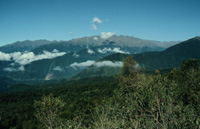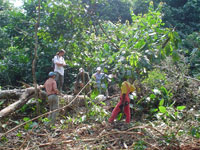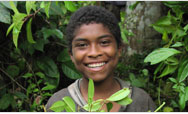
|
Global Climate Change: Sustainable Land Use and Forestry
 Forest/mountain range in Bolivia. Kristine Heine, USAID
Overview
The surface temperature of the earth is warming and concentrations of greenhouse gases (GHGs), especially carbon dioxide, have increased substantially since the beginning of the Industrial revolution. The National Academy of Sciences indicates this increase is due in large part to human activity, and in its report concludes that significant areas of uncertainty remain, including how much effect natural fluctuations in climate may have had on warming, how fast climate changes will occur, the magnitude of those changes, and their impacts. As human populations and economies grow, many of which are currently highly dependent on carbon-based fossil fuels, GHG emissions will also likely rise. Since climate change affects the global environment, human populations, and economic development, the challenge to the global community is to further economic development while also limiting the associated growth in GHG emissions.
Carbon sequestration is the process of storing carbon in living plant matter and the soil once it has been transformed from carbon dioxide in the atmosphere. Carbon dioxide, the most abundant GHG, is taken from the atmosphere by plants through the process of photosynthesis. As the plants grow, they take up and store, or sequester, carbon. As the plants die, the carbon-based leaves, stems, and roots decay and become organic matter in the soil. This organic matter can either become a “sink” for the carbon it contains, meaning that it can store the carbon over time, or it can become a “source” of carbon emissions to the atmosphere, depending on how the land is treated. The world’s forests, wetlands, grasslands, and agricultural ecosystems serve an important role in the planet’s carbon cycle by storing a considerable portion of the global carbon stock. When these systems are altered due to activities such as timber harvesting, clear cutting, or unsustainable expansion of agriculture that contribute to erosion and leaching, the important function of sequestering carbon is removed. The result is that the carbon stock of the system decreases, once the rate of carbon loss becomes greater than the rate of carbon input.
Forest burning and unmanaged forest fires also cause carbon to be released into the atmosphere, acting as a direct source of global GHG emissions. It is estimated that approximately 20 percent of annual global carbon emissions result from land-use changes to forested ecosystems.(1) Through efforts to reduce deforestation and burning, as well as improve agricultural practices to increase soil organic carbon, land-based carbon sequestration can help reduce the buildup of GHGs in the atmosphere.
 Foresters and scientists assess the carbon impact of felled tree on surrounding forest in northern Republic of Congo. Carrie Stokes, USAID
USAID’s Approach
Through its activities in biodiversity conservation, improved forest management, and sustainable agriculture, USAID has programs in more than 25 countries that increase, maintain, or reduce the rate of loss of carbon stocks. These efforts help mitigate climate change by “soaking up” carbon dioxide that has been emitted to the atmosphere. They also help reduce the vulnerability of ecosystems to the potential impacts of climate change. Reduced-impact logging of forests minimizes loss of vegetative cover, which helps stabilize the soil and prevent it from eroding away during rain and windstorms. For agricultural activities, reduced tillage and contour planting lead to an increase in soil organic carbon and therefore in soil fertility, which helps increase food security for agrarian societies in developing countries.
Across its forestry, biodiversity, and sustainable agriculture programs, USAID has initiated activities that protect carbon stocks in more than 120 million hectares around the world. Primary efforts have been focused in Latin America, Africa, and the Russian Far East. For example, USAID’s Parks-in-Peril (PiP) program in the Latin America and Caribbean region strengthens conservation capacity at specific sites in 15 countries. PiP supports local governments, nongovernmental organizations, and communities by building the capacity to manage and conserve protected areas, by providing technical assistance on conservation practices, and by supporting targeted policy reforms. The program works to develop long-term self-sufficiency through assistance with strategic planning, ecological monitoring, financial accounting, geographic information systems (GIS) analysis, and community-based management.
In Africa, the Central African Regional Program for the Environment (CARPE) focuses efforts in 11 specific landscapes located across the Congo Basin, which holds massive expanses of closed canopy tropical forest. The region is threatened by unsustainable timber exploitation, shifting cultivation, urban expansion, and decades of human conflict. In addition to providing other valuable ecosystem services, the large forested area of the Congo Basin serves as a globally important carbon stock. CARPE’s principal goal is to reduce the rate of forest degradation and loss of biodiversity through increased local, national, and regional natural resource management. Key activities include protected area management, natural resources management planning, improved logging policies, sustainable forest use by local inhabitants, and improved environmental governance. USAID’s efforts in this region have helped to establish the recently announced Congo Basin Forest Partnership, which has resulted in agreements among six Central African countries to implement activities spanning an area of 67 million hectares.
Carbon sequestration efforts are also underway on the degraded lands in the Sahel region of West Africa. In the upper valley of the Niger River in Mali, USAID has introduced agricultural practices to help farmers improve soil fertility, increase crop yields, and reduce the need to clear new lands. In Senegal, USAID has helped create a national team of experts to undertake analyses of carbon sequestration potential throughout the country. This work has formed the basis for a larger effort to form national carbon assessment teams in other countries of the Sahel.
Related Links
Linked documents may require Adobe Acrobat Reader for viewing.
Disclaimer of Endorsement
The pages and documents posted on this Web site may contain links or references to information created and maintained by other public and private organizations, which do not necessarily reflect the views of USAID.
The Russian Far East and Siberia account for approximately 22 percent of the world’s forests. They provide habitat for endangered species, represent an important economic resource, and serve as a globally significant carbon sink. They are threatened, however, by uncontrolled forest fires, pest outbreaks, illegal logging, and poor harvesting practices. USAID’s Forestry Resources and Technologies (FOREST) project works to protect forests through pest management, fire prevention campaigns, promotion of non-timber forest products, and biomass energy development. USAID is also working with the Ministry of Natural Resources on forest planning, inventory and monitoring, fire ecology research, reforestation, and forest policy development. The results of these efforts have increased Russia’s capacity to predict and control forest pest outbreaks as well as to implement a successful fire prevention campaign modeled after the “Smokey Bear” effort in the United States. The FOREST project has also demonstrated the viability of biomass as an alternative energy source by installing four facilities in the Russian Far East and Siberia and bringing economic, social, and environmental benefits to the region.
Conclusion
To better understand the carbon effects of land management projects, scientists, policymakers, and landowners in the international community need improved methods for monitoring carbon sequestration in soil-plant ecosystems. Therefore, in addition to promoting activities that preserve carbon stocks, USAID is helping to develop a methodology for quantifying the carbon impacts of its land-based programs. By using remote sensing, GIS analysis, ground-truthing techniques, and statistical analyses, these quantification methods will help USAID better understand the carbon balance and the cobenefits of its own sustainable land-use projects, as well as contribute to the carbon literature used by the international community at large.
Footnotes
1. Food and Agriculture Organization of the United Nations, State of the World’s Forest (1997).
Please note, many links in the Global Climate Change portion of USAID's web sites point to information on the U.S. State Department and White House web sites. Some of these materials may be under review and temporarily unavailable. These links will be updated on USAID's web sites as soon as possible. Thank you for your patience.
Back to Top ^
|




